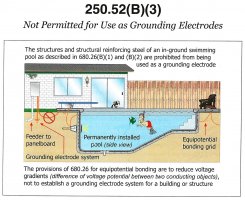I have a question. A pool is being built with an existing CMU fence located less than five feet from the waters edge. Is the wall steel required to be included in the equipotential bonding grid?
I say yes. The standard approach is breaking into the footing and getting to the steel. I have caused it to happen many times as have other inspectors that I work with and also from other jurisdictions.
Now I have been challenged by an inspector and an electrical engineer. The supposition is that because the steel can’t be touched it doesn’t need to be bonded.
I say yes. The standard approach is breaking into the footing and getting to the steel. I have caused it to happen many times as have other inspectors that I work with and also from other jurisdictions.
Now I have been challenged by an inspector and an electrical engineer. The supposition is that because the steel can’t be touched it doesn’t need to be bonded.

